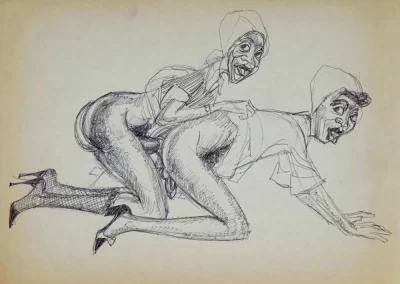ART WRITING
REVIEWS
Berry Horton
Art in America, October 24, 2016
In order to forestall harassment from local authorities, Redbud posted a sign in the gallery window reading notice: erotic material during its recent show of work by little-known Chicago artist Berry Horton (1917–1987). This notice might have seemed unnecessary to visitors who viewed only the ink-brush drawings of female nudes in the gallery’s main space. In these works, Horton wields a sinuous, tapering black line to depict—with just a few strokes—slender figures who appear to pose for an art class or perform a sensuous dance. However, to anyone who found his or her way into the gallery’s back room and sat down at the coffee table to peruse the multiple portfolios labeled adults only, the reason for the sign out front became immediately clear.
Undated (though likely made in the 1930s or 1940s), unsigned, and, until now, unknown to the public, these portfolio drawings turn away from the elegant eroticism of the front-room nudes, exploding in favor of explicit depictions of frenzied sexual activity, much of it involving transgender figures. Nearly all the figures possess penises, often of enormous size, while sporting feminine footwear, hairstyles, and headgear. As I began to slowly leaf through the portfolio drawings, I realized I was in the presence of a double miracle: it was miraculous that such transgressive art had been made in the first place, and equally miraculous that these scandalous drawings by an obscure artist had survived at all.
Although involved with Chicago’s South Side Community Art Center, a Works Progress Administration project that promoted notable figures from Jacob Lawrence to Gwendolyn Brooks, Horton exhibited little during his lifetime, and, as far as I can determine, never showed any of the erotic portfolio drawings, which, after his death, were preserved by Susan Cayton Woodson (1918–2013), a prominent African-American art collector and dealer in Chicago. One thing that immediately sets the drawings apart from contemporaneous work is how Horton, who was African-American, dropped into them specific allusions to the flourishing gay and lesbian scene in Bronzeville, as Chicago’s Southside black neighborhood was then called.
A gifted draftsman, Horton worked in a number of different styles. One mode, which relies on finely drawn contour lines, suggests the influence of Mayan codices, African sculpture, and Pacific Northwest Native American art, as well as, most likely, a familiarity with Jungian psychology. These drawings depart dramatically from conventional anatomy; their figures might have animal-like masked heads perched atop many-breasted torsos or comprise only legs and pelvises. When Horton does show us an entire figure from head to foot, he frequently rotates the upper or lower half in anatomically impossible ways. In one such drawing, the figure faces us from the waist up, while below we see her buttocks and the backs of her legs. Sprouting unexpectedly from between her butt cheeks is a single large eye situated above a pair of smiling lips showing teeth; her feet are shod in pointy ballet slippers; her hair is concealed beneath a headwrap. The majority of the figures in the portfolio drawings wear headwraps, and many of them have recognizable African-American features.
In a second mode of drawing, involving cross-hatching and sketchier lines, Horton made the racial identity of his subjects as explicit as the sexual nature of their actions. One example depicts two figures engaged in anal sex while decked out in headwraps and high heels. Their smiling faces are turned toward us, inviting us to approve of and maybe join them in their pleasurable act, even as we register the headwraps as charged signifiers of African-American oppression and cultural identity. In another drawing, Horton squeezes three figures onto the paper, two of them upside down in relation to the central figure. This might be a riff on the trio of goddesses in Cranach’s Judgment of Paris or just an assembly of three sketches, but in either case the sexual intensity of the figures (muscular bodies, frilly garments, erect nipples and penises) along with the specificity of their faces makes the drawing unforgettable.
At once deeply private and socially acute, Horton’s drawings interweave the subjects of queerness and race. Their long-delayed emergence is, I believe, a significant event in American art history.
